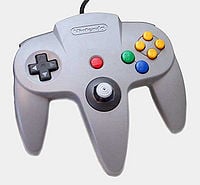Nintendo 64 controller
The Nintendo 64 controller is the default controller for the Nintendo 64. It can be used to play Super Smash Bros. The controller has a unique three pronged M-shape, as Nintendo did not know if the use of analog sticks would become widespread and covered their bases by making the controller comfortable to hold in multiple ways. A majority of the Nintendo 64's games require players to grip their left hand on the middle handle and their right hand on the right handle, including Super Smash Bros. Some games, however, did allow players to hold the controller's left and right prongs to control the game, such as Dr. Mario and Kirby 64: The Crystal Shards. The third option is to hold the left handle with the left hand and the middle handle with the right hand, although this was never implemented for any games. Sin and Punishment considered using this option, but abandoned the idea out of fear of alienating players. The controller has among the lowest latency out of Nintendo's controllers with minimal variance, being as low as 48ms (2.8 frames) and as high as 66.4ms (almost 4 frames)[1].
Two official add-ons were released for the controller: the rumble pak, a device that vibrates under certain conditions to increase immersion which Super Smash Bros. utilizes, and the controller pak, which could save data for some games like Quest 64.
There are a few third party controllers available for the Nintendo 64, such as the Hori Mini Pad. It is also possible to use unofficial adapters to connect other controllers to the Nintendo 64, including keyboards, GameCube, and Xbox among others.
An official wireless Nintendo 64 controller for Nintendo Switch was released in October 2021, which can be used with Super Smash Bros. Ultimate. It is treated as a Nintendo Switch Pro Controller, meaning it is unofficially compatible with all games that support that controller. The layout is the same as a standard Nintendo 64 controller, only differing with an added ZR button, Capture button, Home button, Sync button, built-in rumble and a USB-C connector in place of the cord. The C buttons act as digital inputs for the right control stick, allowing for smash attack buttons. They can be mapped to jump like the original controller in the Controls menu.
Standard Controls
Super Smash Bros.
| Move | |
| Standard attacks | |
| Special moves | |
| Jump | |
| Shield | |
| Grab | |
| Taunt | |
| Pause | |
| Move (menu only) |
Super Smash Bros. Ultimate
Note: Only applies to the wireless N64 controller. Does not include additional buttons added to that specific model. All buttons listed are mappable.
| Control | Nintendo Switch reads as | Action |
|---|---|---|
| L |
Move | |
| Standard attacks | ||
| Special moves | ||
| R |
Smash attacks | |
| Grab | ||
| Shield | ||
| Pause | ||
| Taunts |
In competitive play
In the earliest days of the franchise and its competitive scene, the official Nintendo 64 controller was the tournament standard. This was due to no preferable alternatives being available at the time and the console requiring a controller that fits the proprietary Nintendo 64 controller port. Due to being incompatible with Nintendo's next console, the GameCube, the N64 controller only continued to see frequent use at Smash 64 tournaments. After the rise of preferable alternatives like the Hori Mini Pad and emulators removing the restrictions imposed by official hardware, official controllers have generally fallen out of favor at top level play. While not necessarily an uncommon sight at tournaments, most of the best Smash 64 players in the world have officially retired the controller in favor of something else.
The wireless N64 controller compatible with Nintendo Switch similarly are a rarity in Ultimate tournaments due to the plethora of preferable alternatives and the limited stock exclusive to customers with an active Nintendo Switch Online subscription.
Gallery
References
| Controllers and buttons | |
|---|---|
| Nintendo 64 controller | |
| GameCube controller | |
| Wii Remote (and Nunchuk) | |
| Classic Controller | L |
| Nintendo 3DS | |
| Wii U GamePad / Pro Controller | L |
| Joy-Con | |
| Switch Pro Controller | L |
| Third-party controllers | Hori Mini Pad · Arcade controller · Keyboard |
| Other | Smash Controller · Controller modification |


